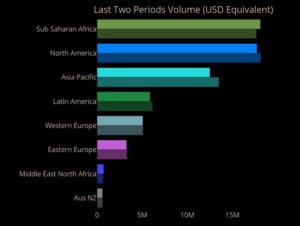Guest blog by IDC bloggers: Nimita Limaye and Michael Townsend
Despite a challenging 2020, the medical device market is expected to rebound, albeit slowly in 2021. Increasing pressure on revenue and margins have spurred the industry to accelerate innovation and adopt agility at scale. The COVID-19 pandemic has further accelerated digital transformation, driven by the need for zero-touch, automated processes, and the use of real-time predictive analytics to enable decision making. In this blog post, we will look at both the challenges and opportunities for the medical devices industry. Firstly, let’s talk about the challenges:
- One of the first is medical device regulatory compliance. The medical device industry has long struggled in dealing with numerous country specific and changing regulations such as QSR CFR 21, ISO 13485, and other evolving EU MDR and IVDR regulations. Accelerating product innovation further exacerbates the struggle of ensuring development processes are fully in accordance with compliance and an ever-evolving regulatory landscape. The transformational changes in the EU regulatory landscape, the delays in the implementation of the EUDAMED database, the insufficient number of designated notified bodies, and the lack of sufficient guidance documents have posed significant challenges to the medical device industry.
- The second challenge is associated with the fact that medical devices are becoming smarter. The industry has acknowledged that product innovation and differentiation is dependent on increasingly complex software. The increasing demand for non-invasive, connected medical devices, complemented by the escalated demand for remote patient-monitoring due to the COVID-19 pandemic, is driving increased adoption of intelligent medical devices based on the Internet of Medical Things (IoMT). There is also increasing growth in software as a medical device (SaMD), which is standalone software that itself serves as a medical device, and is not a part of another medical device, as well as in software in a medical device (SiMD), meaning software that powers medical device functions.
- The third challenge is global competition, which requires companies to become more productive. Engineering teams need to focus more than ever on engineering and not process. Process is important but short of hiring more engineers, businesses need to increase the productivity of the engineers they have. Given that the largest number of medical-device recalls between 2013-2018 were classified as device design related, as well as the growing number of Class I recalls, it is essential that engineers focus on engineering.
Medical device manufacturing companies have leveraged both manual processes and project management tools to oversee product development through design, introduction, growth, maturity/stability, and decline. The addition of a software component adds a new level of complexity to this process. For example, QSR CFR 21 requires manufacturers to not only ensure compliance with good manufacturing practices (GMP), but to also ensure that products meet the defined requirements and specifications. The lack of design controls is one of the major causes of medical device recalls and audit violations. In 2020, medical recall activity reached levels not seen in the past two years, with a projected increase of 35% over 2019. Recalls have resulted from multiple problems including those related to manufacturing defects, quality, labeling, software, and a growing number of safety issues. Apart from the financial implications, product recalls put an organization’s reputation at stake, significantly amplifying the impact of product recalls. Therefore, measures need to be in place to ensure regulatory compliance for the software component as well. With software now a key component of medical devices, the ability to track and streamline its development process is critical. With Industry 4.0 rapidly becoming a reality, there is a need for enterprise-scale engineering life-cycle management (ELM) solutions that enable development teams to oversee the parallel development of the most complex systems and software.
Many companies are adopting ELM, also referred to as application life-cycle management (ALM), to address these challenges. ELM is an end-to-end, integrated systems and software development solution for complex development management. Compliance with EU MDR and IVDR regulations requires the creation of clinical evaluation reports (CER), which are critical compliance deliverables required for both new and currently marketed products. CERs require medical device manufacturers to provide traceability between product requirements at the intended use environment, as well as original design, and verification and validation procedures, both for analytical and clinical validation purposes. ELM enables that traceability for the hardware and software development cycle of a medical device and enables engineers to manage each stage of the medical device life cycle efficiently (see Figure 1).

Figure 1: ELM: Intelligence Integrated across the Engineering Life Cycle
Benefits of Engineering Life-cycle Management (ELM)
- An ELM solution serves as a digital foundational platform for leveraging artificial intelligence (AI), analytics, and virtual modeling across the engineering life cycle. It also helps to manage product complexity and ensure accurate reporting and regulatory compliance.
- Such a solution eliminates siloed development processes and strengthens the controls around transparency and product traceability across engineering teams, providing an end-to-end, multidisciplinary, and cross-functional governance strategy as required by the EU MDR. Transparency and traceability are becoming more critical to ensure ongoing product quality and safety, as software is continually updated.
- ELM supports continuous verification and validation, helping to ensure product safety and reliability, comprehensive change management for impact analysis, and collaboration across teams and stakeholders so all development is in lockstep.
- ELM drives regulatory compliance. With growing concerns regarding cybersecurity threats and stringent data security and privacy regulations such as HIPAA and GDPR, robust and auditable ELM solutions add enormous value. With an increase in the use of SAMD and SiMD, there is a heightened focus by regulators to evaluate whether adverse events are linked to software or cybersecurity issues, especially in light of a recent report by the Australian Therapeutic Goods Administration reporting clear examples of harm caused by medical software. In addition, automating the capture, recording, and traceability of the steps in the software development life cycle (SDLC) not only drives efficiencies while ensuring regulatory compliance, but it can also speed development time. Today’s design engineers are incorporating hardware, software, and connectivity into engineering systems, but they are also designing for data acquisition, storage, and analysis. ELM solutions can provide real-time contextual data and much needed visibility to “smoke signals,” flagging critical issues in advance.
- These solutions can enhance productivity for medical device development teams, which can leverage ELM’s support of strategic reuse of product and software engineering work across multiple product lines. Reusing components/parts that have been previously certified can reduce time to market and avoid costs.
Recommendation
As medical device companies develop increasingly complex products, every organization needs to assess where it is in its journey. There is clear and growing evidence for businesses to adopt enterprise-level agility models in an increasingly digital world. ELM can provide the foundation for medical device companies to be more competitive and ensure product safety and regulatory compliance through better management of parallel systems and software development.
- 2019
- 2020
- 2021
- 7
- acquisition
- Adoption
- AI
- All
- analysis
- analytics
- Application
- around
- artificial intelligence
- Artificial intelligence (AI)
- audit
- Automated
- Blog
- businesses
- caused
- challenge
- change
- clinical trials
- collaboration
- Companies
- competition
- compliance
- component
- Connectivity
- Costs
- COVID-19
- COVID-19 pandemic
- Cybersecurity
- data
- data security
- Database
- dealing
- Decision Making
- delays
- Demand
- Design
- develop
- Development
- Devices
- digital
- Digital Transformation
- documents
- driven
- driving
- Engineering
- Engineers
- Environment
- EU
- events
- fda
- Figure
- financial
- First
- Focus
- Forbes
- GDPR
- Global
- goods
- governance
- Growing
- Growth
- Hardware
- Hiring
- HTTPS
- IBM
- IDC
- Impact
- Including
- Increase
- industry
- Innovation
- Intelligence
- issues
- IT
- Key
- labeling
- launch
- Level
- Leverage
- light
- Long
- major
- Making
- management
- manufacturing
- Market
- medical
- medical device
- medical devices
- modeling
- Other
- pandemic
- platform
- Predictive Analytics
- pressure
- privacy
- Product
- product development
- Product Innovation
- Product Quality
- Production
- productivity
- Products
- project
- project management
- quality
- real-time
- Reality
- reduce
- regulations
- Regulators
- Regulatory Compliance
- report
- Reports
- Requirements
- research
- revenue
- Risk
- risk assessment
- Safety
- Scale
- security
- Short
- smart
- So
- Software
- software development
- software engineering
- Solutions
- speed
- Stage
- stake
- storage
- Strategic
- Strategy
- support
- Supports
- Systems
- Therapeutic
- threats
- time
- Traceability
- track
- Transformation
- Transparency
- value
- Verification
- Virtual
- visibility
- Wheel
- Work
- world
- years




